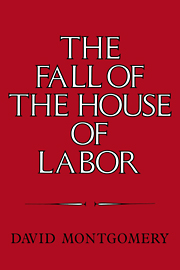Book contents
- Frontmatter
- Contents
- Acknowledgments
- Abbreviations used in text and notes
- Introduction
- 1 The manager's brain under the workman's cap
- 2 The common laborer
- 3 The operative
- 4 The art of cutting metals
- 5 White shirts and superior intelligence
- 6 “Our time … believes in change”
- 7 Patriots or paupers
- 8 “This great struggle for democracy”
- 9 “A maximum of publicity with a minimum of interference”
- Index
8 - “This great struggle for democracy”
Published online by Cambridge University Press: 11 September 2009
- Frontmatter
- Contents
- Acknowledgments
- Abbreviations used in text and notes
- Introduction
- 1 The manager's brain under the workman's cap
- 2 The common laborer
- 3 The operative
- 4 The art of cutting metals
- 5 White shirts and superior intelligence
- 6 “Our time … believes in change”
- 7 Patriots or paupers
- 8 “This great struggle for democracy”
- 9 “A maximum of publicity with a minimum of interference”
- Index
Summary
By Election Day in 1916, the economy of the United States had been partially mobilized for war production. In this context, business not only had perfected new leadership structures, such as the NICB, and new labor strategies, such as the Colorado Industrial Plan, but also had institutionalized an economic directorate within the machinery of the federal government, most notably in the Council of National Defense (CND). Simultaneously, the unprecedented demand for labor and for workers' votes had given a new lease on life to a union movement earlier stymied by the open-shop drive and had reshaped political alliances within that movement. The formal declaration of war in April 1917 merely accelerated all these developments, paving the way for a decisive confrontation between the working class and the state in the years 1919–22.
Paradoxically, during March and April 1917, although the cost of living soared, provoking food riots in New York and Philadelphia, unemployment also rose. The collapse of the tsar's armies had cost the munitions industry a major market. But soon domestic demand picked up the slack, and the combined impact of rising prices and full employment unleashed the largest strike wave the United States had seen up to that time. Between April 6 and October 5, 1917, statisticians of the NICB calculated that 6, 285, 519 workdays were lost because of strikes, a figure that dwarfed even the record militancy of 1912–13 and 1915–16.
- Type
- Chapter
- Information
- The Fall of the House of LaborThe Workplace, the State, and American Labor Activism, 1865–1925, pp. 370 - 410Publisher: Cambridge University PressPrint publication year: 1987



